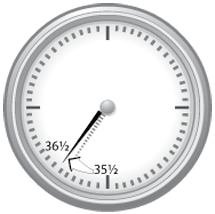2010 Urban Congestion Trends
Enhancing System Reliability with Operations
Download the Printable Version (PDF, 2.9 MB)
You will need the Adobe Acrobat Reader to view this PDF.
For More Information: https://ops.fhwa.dot.gov/perf_measurement/index.htm
Contact Information: Operations Feedback at OperationsFeedback@dot.gov.

U.S. Department of Transportation
Federal Highway Administration
Congestion increased slightly over the past year in 20 urban areas in the United States.
According to the FHWA Traffic Volume Trends report, more traffic was on the road in 2010 compared to 2009. This increased traffic can cause increased congestion. While edging up slightly in 2010, congestion has not reached the levels experienced in 2007, prior to the economic downturn.
The implementation of innovative traffic operations strategies is even more important with this slight uptick of congestion. As the economy improves, the use of operational strategies will become more important to alleviate increasing congestion.
There are a number of success stories documented in this report that illustrate how some states and communities are more effectively implementing traffic operations and monitoring and evaluating impacts. The benefits of successfully implementing operational strategies typically include reduced travel time, less fuel consumption, fewer emissions, and increased safety.
Congestion Facts
- All three congestion measures—daily hours of congestion, time penalty for each trip, and worst-trip time penalty—have increased slightly.
- Congestion has increased in almost all monitored regions to some degree.
- Travel time on the worst day per month increased for 17 of the 20 monitored regions.
- At least one of the three measures indicated increased congestion in 18 of 20 monitored regions.
- Congestion is generally lowest during the summer vacation season as evidenced by trip times.
Congestion Measures
- Hours of congestion—amount of time when freeways operate below 50 mph.
- Travel Time Index (TTI)—time penalty for a trip on an average day. A TTI of 1.30 indicates a 20-minute free-flow trip takes 26 minutes in the rush hours.
- Planning Time Index (PTI)—time penalty for a trip to be on time for 95 percent of trips (i.e., late for work on one day per month). A PTI of 1.60 indicates a 20-minute free-flow trip takes 32 minutes to be late for work only one day per month.
Hours of Congestion Each Day

Congested time increased 18 minutes from 2009 to 2010, from 4:20 to 4:38.
Time Penalty Each Trip

The time to make a trip that takes 30 minutes in free-flow conditions increased from 35.5 minutes in 2009 to 36.5 minutes in 2010.
Worst-Trip Time Penalty

Travel time to be late for work only one day per month (for a 30-minute trip) increased from 44 minutes in 2009 to 45.5 minutes in 2010.
The clock hands show the time wasted in 2009 (dashed) and 2010 (solid).
Data from traffic operations centers and public-private partnerships were provided to the Federal Highway Administration from the following regions: Atlanta, GA; Boston, MA; Chicago, IL; Detroit, MI; Houston, TX; Los Angeles, CA; Minneapolis-St. Paul, MN; Oklahoma City, OK: Orange County, CA; Philadelphia, PA; Pittsburgh, PA; Providence, RI; Riverside-San Bernardino, CA; Sacramento, CA; St. Louis, MO; Salt Lake City, UT; San Diego, CA; San Francisco, CA; Seattle, WA; and Tampa, FL.
Addressing Congestion With Effective Operations
What Causes Congestion?
Too much traffic demand and/or not enough supply causes congestion. High traffic demand is expected during rush hours, or there might be a special event causing the high demand. "Supply" is the capacity of travel lanes. Too little supply is caused when there are simply too few lanes or reduced lanes because of construction, a traffic crash or other incident. Even poor weather can cause reduced lane capacity.
We have all experienced congestion. It makes us late for meetings, picking kids up from daycare, and spending time with family. It also wears away at our vehicles, and causes us to spend more on gasoline.
Everyone has a different tolerance for congestion—depending upon the level of congestion encountered day-to-day. Congestion occurs when we cannot travel at free-flow speeds as we would like. The level of congestion can vary by day as well, meaning travelers and freight shippers must allow extra time to ensure on-time arrivals.
Why is Travel Time Reliability Important?
Travelers and shippers desire a consistency in travel times from day-to-day and throughout the day. They like to know what to expect. Travel time reliability allows them to know what to expect.
Expected congestion during the rush hour is often better tolerated by motorists than delays caused by unexpected incidents such as crashes or a construction work zone. Motorists will remember the few bad days spent in traffic more than the average travel time along a route. Communicating average travel conditions misses the unreliable days. Reporting on reliability is important to capture these unexpected incidents.
For More Information:
https://ops.fhwa.dot.gov/publications/tt_reliability/brochure/
Reporting Mobility and Reliability Performance
The Georgia Regional Transportation Authority (GRTA)
Buffer Index
The buffer index is the percent difference between the average travel time and 95th percentile travel time. It expresses the amount of extra "buffer" time needed to be on time for 95 percent of trips (i.e., late for work on one day of the month).
The Georgia Regional Transportation Authority provides an example of documenting travel time reliability performance.
GRTA produces a Transportation Metropolitan Atlanta Performance (MAP) Report each year, which includes performance in six general categories including mobility. Mobility is measured through use of the travel time index and reliability is measured with the planning time index and buffer index. Georgia DOT's NaviGAtor video detection cameras are used to obtain speed and volume data.
Reporting Mobility and Reliability Performance
The Transportation MAP Report provides a useful reference for monitoring trends and information transportation decisions in the Atlanta, Georgia region.
The Transportation MAP Report provides a useful reference for monitoring trends and informing transportation decisions. Results in the 2010 Transportation MAP Report show that freeway congestion during the morning and evening peak period improved since it peaked in 2006 (as measured by the travel time index). Similar positive changes were identified in the two reliability measures as well—the planning time index and buffer index. Results are presented with a variety of informative maps, tables, and figures.
For More Information:
http://grta.org/valentin/2010_Transportation_MAP_Report.pdf
Success Stories in Operational Improvements
The following success stories highlight innovative ways states and communities throughout the United States have reduced congestion through effective operations. These case studies focus on evaluation of operational strategies.
Tyler, Texas: Adaptive Signal Control Technologies (ASCT)
Adaptive Signal Control Technologies
Traditional arterial signal systems operate with fixed timings based upon expected traffic volumes during certain portions of the day. ASCT can adjust to handle varying traffic conditions that may differ from fixed-time operations to improve traffic flow.
(Benefits: reduced congestion and delay, fewer stops, reduced fuel consumption, improved trip reliability)
The Investment
Traffic conditions along Highway 69 and Highway 323 are highly variable and generated frequent citizen complaints, which required the time and attention of engineering staff to investigate and resolve. ASCT was installed on 16 intersections along Highway 69 and Highway 323. The project included geometric improvements, upgrades to signal control equipment, detection and communication systems.
The Return
Traffic operations in Tyler have shifted from a reactive mode dependent on complaints to a proactive mode that provides better performance for the traveling public.
Highlights of the return on investment include:
- Congestion improvements result in an annualized benefit to users of $1.6 million.
- Annual savings of $40,000 per year to the agency because signals do not need to be retimed.
FHWA has launched their Every Day Counts (EDC) Initiative aimed at shortening project delivery, enhancing the safety of roadways, and protecting the environment. ASCT is a tool that meets the goals of this initiative.
For More Information:
https://www.fhwa.dot.gov/everydaycounts/technology/adsc/
Los Angeles: Traffic Incident Management
I-710 Big-Rig Freeway Service Patrol
Service Patrol Incident Management
Collisions and stalled vehicles are rapidly removed by tow trucks or other service vehicles.
(Benefits: Less unexpected delays, fewer collisions caused by stalled vehicles)
The Investment
Interstate 710 (I-710) is the corridor for shipping goods to market from the ports of Long Beach and Los Angeles. Trucks make up 45 percent to 60 percent of I-710's traffic. The Big-Rig Program, a form of traffic incident management, added large tow trucks capable of removing 18-wheel trucks from the stretch of freeway north of the ports. The big-rig service patrol succeeds because it is a combination of technology—heavy-duty tow trucks and operators who identify and aggressively remove crashes and stalled trucks.
The Return
Congestion declined and there was an improvement in reliability as shown in the graphic. Similar improvements were seen in the middle of the day when freight traffic mixes with people trying to get to medical appointments, business meetings, school and other activities.
For More Information:
http://www.its.berkeley.edu/publications/UCB/2005/WP/UCB-ITS-WP-2005-3.pdf
State of Ohio: Work Zone Management
Work-Zone Management
Ensure minimal disruption of traffic flow during construction and maintenance.
(Benefits: Faster, more reliable trips and improved safety)
The Investment
In 2000, the Ohio Department of Transportation (ODOT) established a strategic initiative to improve practices related to maintenance of traffic. ODOT identified their extensive construction program as the likely largest cause of congestion in the state. There were questions about whether the increased work zones would cause more crashes. ODOT staff logged and analyzed hundreds of work zone crashes to evaluate the trends. ODOT developed an extensive "Maintenance of Traffic" policy for traffic management in work zones. Subsequent processes were developed to evaluate work zone crash rates in near real time. Among other items, the traffic management policies in work zones limit the number of lanes that can be closed during peak periods.
The Return
ODOT compares the size of its annual construction budget to the total number of annual work zone crashes. They have found that increased spending on construction is leading to a downward trend in work zone crashes.
ODOT staff also evaluates work zone crash reports in near real time to identify locations of unusually high rates of crashes. If these locations are identified, field visits are used to identify and alleviate causes, improving traffic flow.
For More Information:
https://ops.fhwa.dot.gov/wz/
State of Indiana: Photogrammetry for Crash Reconstruction
IN-TIME (Indiana-Traffic Incident Management Effort)
Photogrammetry Traffic Incident Management
Obtaining geometric characteristics from photographs using computer software allows crash reconstruction personnel to map a crash scene faster than traditional methods.
(Benefits: Less unexpected delays and fewer secondary crashes)
The Investment
The traffic incident management IN-TIME initiative began in 2009. Indiana State Police employ easy-to-use photogrammetry software which produces three-dimensional measurements of a crash scene from photographs. Use of the software reduces the number of field measurements that must be taken, and allows police to open lanes to through traffic more quickly than taking all the field measurements while lanes are blocked.
The Return
From June 2009 to March 2011, the Indiana State Police evaluated the use of photogrammetry at 135 crashes. The Indiana State Police estimated 1 hour and 47 minutes were saved on average per road closing scene. Indiana State Police estimate they have saved over 900 hours of delay to Indiana motorists as a result of using photogrammetry for these 135 crashes.
For More Information:
http://www.in.gov/isp/2816.htm
Performance Management and Operations
Preparing for Performance Management
The highway transportation community is moving towards adapting a Performance Management approach to selecting and funding projects. What is Performance Management? In a nutshell, it is monitoring the performance of the highway system in a variety of "goal areas," evaluating projects to see what has been successful, and using that knowledge to plan for future improvements.
FHWA, the American Association of State Highway and Transportation Officials (AASHTO), the Transportation Research Board (TRB), state DOTs, and Metropolitan Planning Organizations (MPOs) have all been involved in studying Performance Management over the past year. FHWA's Office of Operations has been focusing on system reliability, and specifically, the use of travel-time based reliability measures. As outlined earlier in this Trends brochure, reliability measures not only offer a good view into what travelers experience, but they also can show how operational and other improvements can help to improve reliability and, therefore, the traveler's experience in using the highway network. Look for more to come on this topic in 2011 and beyond.
Data for Performance Management
The Office of Operations has looked into the use of "continuous measurement" of travel times when looking at the issues of reducing congestion and improving system reliability. Specifically, its Freight Performance Measurement program is a proof of concept for such continuous measurement. Truck probe data are being used to develop reliability measures currently on 25 intercity connectors, with plans to expand to urban areas, rural interstates, and other roads of national interest. The key to using probe data such as this is that it can provide much greater national coverage of roadways than our current physical sensors, as well as provide readings at all times of day. FHWA is undertaking further research in this area that shows great promise for providing Performance Management with the robust data it needs to be successfully implemented.
Freight Performance Measurement Program:
https://ops.fhwa.dot.gov/freight/freight_analysis/travel_time.htm
Contact Information
For more information on this report, contact Rich Taylor (Rich.Taylor@dot.gov).
Visit the Urban Congestion Report web site for quarterly congestion trend updates: www.ops.fhwa.dot.gov/perf_measurement/ucr/index.htm.
FHWA-HOP-11-024
You will need the Adobe Acrobat Reader to view the PDFs on this page.